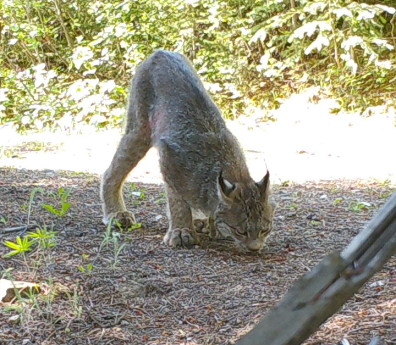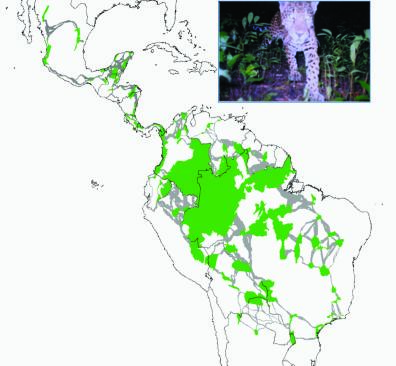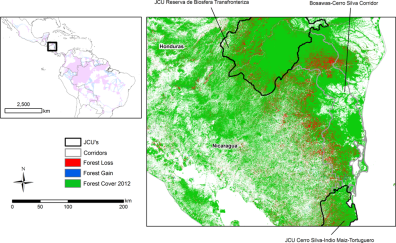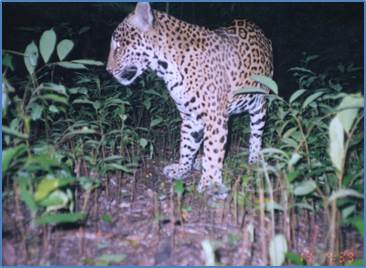CURRENT RESEARCH FOCI
CARNIVORE DISTRIBUTION AND ABUNDANCE
I am currently working on building a better understanding of Canada lynx occupancy and abundance in Washington State and how they may potentially respond to climate and land cover change, as well as other generalist carnivores that are moving upslope. This work includes spatially extensive field work in Washington and Montana to examine lynx distribution, density, and interactions with other carnivores. I am also working on transboundary coordination with Canadian partners to improve cross-border collaboration and integration of datasets. My lab is also engaged in projects to better understand jaguar and other neotropical mammal response to large-scale gradients in hunting pressure within the Maya Biosphere of Guatemala, and response of those same species to forest fragmentation in northern Honduras. A new project with Oregon Fish and Wildlife will seek to generate distribution data on another high elevation carnivore, the Sierra Nevada Red Fox. This effort will seek to better understand environmental drivers of fox distribution and to inform listing status in the state.
CONSERVATION BIOGEOGRAPHY and TRANSBOUNDARY ECOLOGY
A new key theme of my research is examining transboundary ecology and conservation of mammals. Although much thinking in conservation occurs at national or smaller scales, protection of wide-ranging species in the face of extensive changes to ecosystem will necessitate a cross-border, multi-country approach. My lab has led several large-scale spatial analyses to improve conservation planning for carnivores and other large mammals, and we continue to look for ways to integrate cross-border actions in our research.
IMPROVING SURVEY TECHNIQUES FOR CARNIVORES AND OTHER MAMMALS
Large-scale monitoring will be fundamental to successful management and conservation in the 21st century. However, reliably surveying carnivores and other large mammals at appropriate scales for conservation is difficult. Much of our work in this area involves camera trapping efforts, including efforts to design camera-based monitoring of high elevation forest carnivore communities in Washington and efforts to use cameras to conduct landscape-scale surveys in the tropics. Two other current projects seek to use and validate recently developed techniques to generate density estimates of unmarked animals. We also have interests in determining various ways to upscale population estimates, via linkage with remote sensing or combining data across scales.
In collaboration with Dr. Lisa Shipley at WSU, we are beginning a study to examine how a community of sage-brush steppe birds and mammals utilize agroecosystems in central Washington. We are evaluating the species distributions within various components of sage-brush agrosystems, including CRP (restored sage brush), agricultural lands, and native intact and burned sage brush patches. This work includes local and landscape scale assessment of the key drivers of species occupancy, and community dynamics, on multi-use sagebrush landscapes in central Washington. We are also interested in evaluating potential climate-driven changes in species ranges, and how those change intersect with agriculturally dominated sage brush landscapes in Washington.
CO-PRODUCED, ”ACTIONABLE” SCIENCE
We are engaged in several different projects that were developed in close consultation with land managers and agencies. This engagement will hopefully lead to more impactful work from a management viewpoint, and is part of a concerted effort to make research directly relevant to management decisions. These projects include 1) a collaborate effort with Washington Department of Natural Resources to examine forest silvacultural impacts on snowshoe hare in northcentral Washington, and options for making forests more resilient without negatively impacting hare and the species that depend on them (including threatened Canada lynx), 2) an effort to examine response of sage-brush dependent species to wildfire and climate change in central Washington that is part of a grant from the Northwest Climate Adaptation Science Center and involves extensive collaborations with local conservation districts, WA department of fish and wildlife, DoD., and private landowners and 3) developing monitoring techniques for black and white-tailed jackrabbits that are cheap and scalable, so that their status in the state can be better assessed by management agencies.









